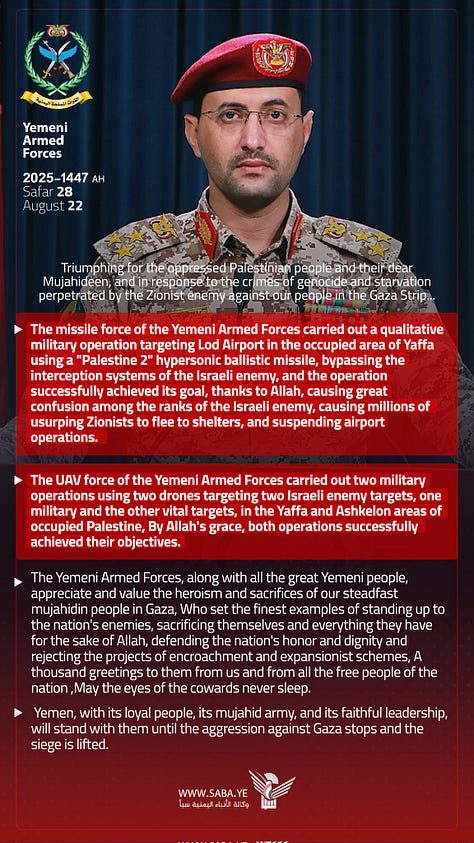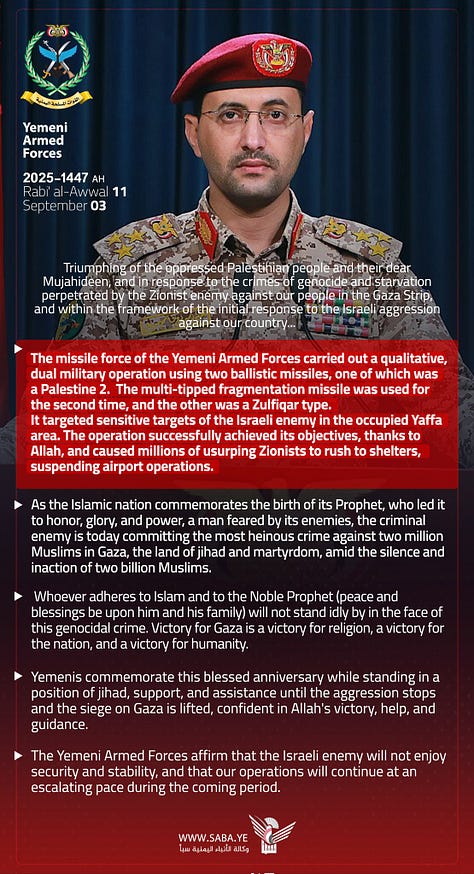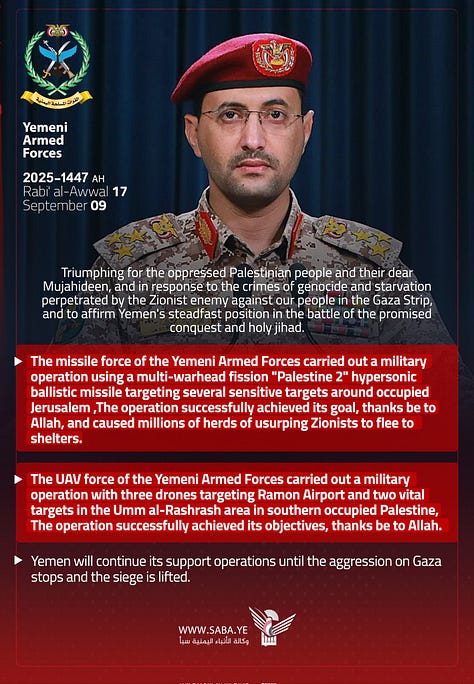Ansarallah Employs Submunition-Dispensing Ballistic Missiles Against Israel
🇮🇷 🇮🇱 🇾🇪
Ansarallah has claimed to have launched another Filisteen (i.e., Palestine) ballistic missile equipped with submunitions (i.e., multiple warheads/cluster warheads) against Israel. Ansarallah has its own designations for Iranian-designed and/or Iranian-built munitions. Filisteen refers to the Iranian Kheybar Shekan-2—the underlying baseline Kheybar Shekan is designated Hatem by Ansarallah.
The baseline Kheybar Shekan is a single-stage solid-propellant ballistic missile design that is optimized to target Israel from western Iran. The baseline Kheybar Shekan lacks the range required to target Israel from Ansarallah-controlled territory in northwestern Yemen. The southernmost Israel city of Eilat is over 1600 kilometers away, the Jerusalem metropolitan area is over 1800 kilometers away, and the Tel Aviv metropolitan area is over 1850 kilometers away. While Ansarallah's arsenal includes the longer-range Toufan, which is a rebranded Iranian liquid-propellant Ghadr ballistic missile, it appears to be regularly using an extended-range version of the Filisteen to target Israel (alongside an extended-range version of the smaller-diameter Zulfiqar liquid-propellant ballistic missile, which appears to be a rebanded extended-range version of the Iranian Rezvan).



While Iran's pursuit of submunitions dispensing payloads for its ballistic missiles has been public knowledge for over a decade, these were thought to have been associated with Iran's larger diameter and greater payload liquid-propellant ballistic missile designs. The first public indication of the existence of a Kheybar Shekan ballistic missile version equipped with a submunition dispensing payload emerged during the June 2025 Iran-Israel War. This particular Iranian version appears to have been used to release a smaller number of larger and heavier submunitions as opposed to a much larger number of much smaller and lighter submunitions. The number and size/weight of submunitions—and the design of the submunitions more generally—carried by a munition reflects the target classes against which it is optimized.
Ansarallah's apparent employment of an extended-range version of the Filisteen—extended-range so as to have the range required to target Israel when launched from northwestern Yemen—capable of dispensing submunitions raises questions about the nature of this modification to the Kheybar Shekan-2 design and the scope of Iranian involvement in this adaptation. The simplest way to increase the range of a ballistic missile and other munitions more generally is to decrease the mass of the payload. A larger fuel tank is ideal, but that is a complex undertaking when it comes to solid-propellant—as opposed to liquid-propellant—ballistic missile designs (it is a far simpler process when it comes to cruise missiles and propeller-driven strike drones).
Although there is presently no indication that Iran has itself deployed the extended-range version of the Kheybar Shekan-2 deployed by Ansarallah in Yemen as the Filisteen, one of the lessons that Iran's IRGC Aerospace Force likely learned from its disappointing performance in the June 2025 Iran-Israel War is the importance of having ballistic missiles that can target Israel from bases in central Iran and, ideally, in eastern Iran, so as to greatly reduce the exposure of ballistic missile launchers and bases to Israeli combat aircraft. The extended-range version of the Kheybar Shekan-2—the Filisteen in Ansarallah's service—amounts to one option that Iran may pursue. The apparent availability of the extended-range version of the Kheybar Shekan-2 with a submunition dispensing payload is something else that Iran may pursue going forward.


